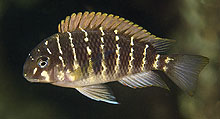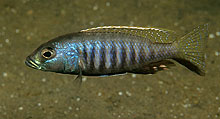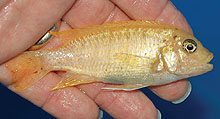WHAT'S NEW ACROSS THE WORLD
Select date in side bar to go to a What's New of previous issues
| What's New
©by Laif DeMason
Wow, talk about being cold… this winter so far takes the cake! People in the Midwest, Northeast, and most of Canada got the worst. Power losses from crippling ice storms were bad for many hobbyists. Fortunately in Florida, the tropical fish farms there had a few cold days, but escaped the worst. Florida’s fish supplies are still fairly secure.
Here’s “what’s new” on the cichlid scene: |
Lake Tanganyika
|
WHAT'S NEW: LAKE TANGANYIKA
|
 Recently, Cyprichromis pavo from Kambwimba, Tanzania, arrived in an import shipment. This large blue species sometimes shows faint broad bars when frightened. Apparently juveniles typically show this pattern from locations in Tanzania but not in Zambia. Photo by A. Konings.
Recently, Cyprichromis pavo from Kambwimba, Tanzania, arrived in an import shipment. This large blue species sometimes shows faint broad bars when frightened. Apparently juveniles typically show this pattern from locations in Tanzania but not in Zambia. Photo by A. Konings.
|
 Over the last years, the gold-orange version of Lamprologus ocellatus has been difficult to find. The aquarium strain was selectively bred from only a few wild individuals. In response, Zambian exporters have collected a similar wild form again, not as colorful as the original strain, but a start.
Over the last years, the gold-orange version of Lamprologus ocellatus has been difficult to find. The aquarium strain was selectively bred from only a few wild individuals. In response, Zambian exporters have collected a similar wild form again, not as colorful as the original strain, but a start.
|
 When nearly all hope of finding nice yellow Altolamprologus calvus outside Sumbu National Park was lost, beautiful wild ones appeared again! Zambian collectors found this fish recently in good enough numbers to sell.
When nearly all hope of finding nice yellow Altolamprologus calvus outside Sumbu National Park was lost, beautiful wild ones appeared again! Zambian collectors found this fish recently in good enough numbers to sell.
|
 Tropheus species and varieties are currently the most popular wild Tanganyikan cichlids. Exporters are now also collecting from little known locations, such as Fulwe Rocks, Tanzania. Not the most colorful T. moorii, but its contrasting markings are pleasing. Photo by A. Konings.
Tropheus species and varieties are currently the most popular wild Tanganyikan cichlids. Exporters are now also collecting from little known locations, such as Fulwe Rocks, Tanzania. Not the most colorful T. moorii, but its contrasting markings are pleasing. Photo by A. Konings.
|

Once in a while, an incidental cichlid from Lake Malawi can be bought here or there. Even rarer is when a not-often-seen cichlid is available with several individuals in the group. Such was the case with Sciaenochromis psammophilus. Not the most colorful fish, but almost never seen in the hobby. Photo by A. Konings.
|

Various Metriaclima fainzilberi forms from different locations are currently popular, especially the OB morphs. I’ve noticed that in wild imports (and bred fish), these OB fish can occur in two forms. One, the OB form, has black markings, the other, the O form, has almost none. Here a wild yellow chin O form from Lundo Island, Tanzania.
|
Select date in side bar to go a What's New of previous issues |